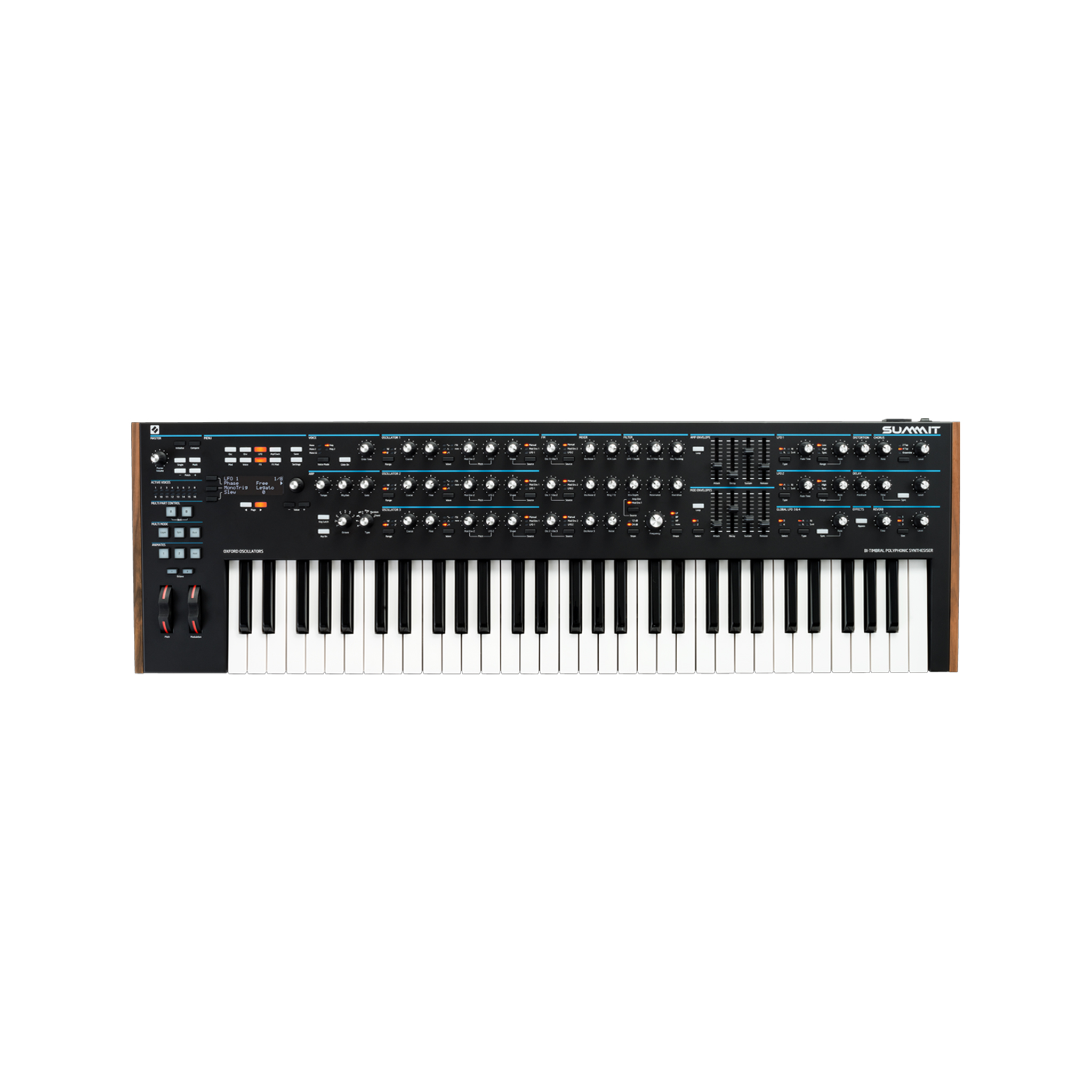Review: Novation Summit
Novation’s Peak synth came out a couple of years ago, to great acclaim. Will the company’s Summit, effectively twin Peaks, have you falling for it?
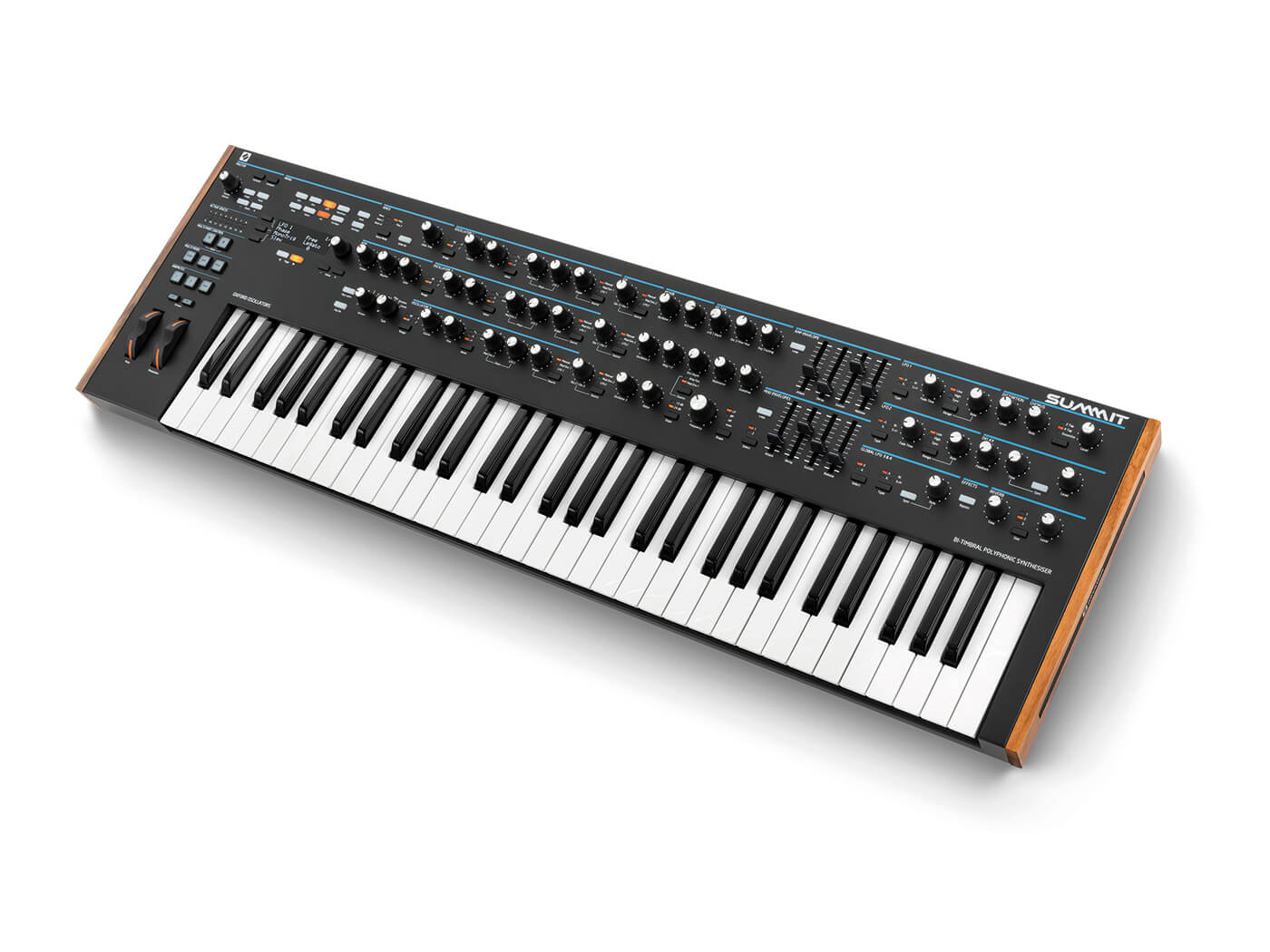

Price £1,899
Contact Novation
Right from the outset, I’m not doing any Twin Peaks puns. (Okay, bar the one in the intro line above.) But it’s hard not to, because the designers at Novation possibly had this infamous 1990s TV show in mind when they developed their new Summit hybrid synth; it, after all, is two Novation Peaks in one box (I even wonder if their chief designer was a superfan of the show and planned this all along).
So no more Peak puns, and definitely no Agent Cooper quotes (although there are some damn fine ones if you look them up, as I just did). Besides, Summit is not just two Peaks. Yes, there is double Peak power, but Novation has thrown in a lot more. But first, a little recap on Peak which, unbelievably, I looked at over two years ago…
Peaky blinder
Peak is still very much a great synth buy and very much part of Summit. So as I talk about it over the following paragraphs, I will simply say what Peak has – and what Summit adds.
At its core, Peak’s signal path starts with ‘analogue sounding’ NCOs (Numerically Controlled Oscillators). These utilise Novation’s Field Programmable Gate Array (FPGA) processor for a high-resolution performance and the ‘analogue sounding’ phrase is important, as this is a digital synth at heart, with other digital body parts added later.
However, the circulation system (if you want to extend the body analogy) is analogue, because the signal takes a true-analogue route through overdrive, filter and distortion sections, adding digital effects later.
The synth’s core oscillators utilise both familiar analogue-style waveforms and numerous extra wavetables. Each voice has three of these oscillators plus noise and ring mod per voice and this is where the first big difference between Peak and Summit comes in. Peak has a maximum of eight notes of polyphony (depending on the voices used per sound) while Summit boasts 16 – it is two Peaks, after all.
The other big and obvious difference is that Peak is bi-timbral; you can play two sounds at once. Again, two Peaks equals two synth sounds, simple. In practice, what this means is that you can play one big 16-voice patch or two eight-voice sounds separately.
There are a lot more than those polyphony and bi-timbral differences, so as we traverse the Summit, I’ll explain more about the hybrid signal flow (and how Novation has makes it feel simple) and of course, more on the differences between the two. As I said, it’s not just a straight doubling up.
Up to the summit
Inevitably, given that it has more features and a keyboard bolted on, Summit’s front-panel layout is a little different to Peak’s, though they are clearly very closely related. Summit has around 50 solid-feeling rotaries and 55 responsive function buttons. The keyboard is the same one as used by the rather glorious SL MkIII controller, which I reviewed last year and feels responsive and playable. Indeed, the whole Summit package feels very well put together and is even sturdier with a full metal chassis and wooden end cheeks. It’s heavy, too.
The dials feature centre-reference points or physical steps for those parameters that require each type, while there are now long-throw faders on the two envelope control sets – longer than Peak’s, so you get greater fine-tune control. Then I should mention that fine OLED screen with clear writing and those illuminated buttons which may sometimes exhibit a logical colour change, depending on what you are selecting. There’s space between everything and nothing feels cluttered as Summit expands its user space to use what is a much bigger footprint than Peak’s.
In use
From left to right, you start with the Multi or Single buttons. These allow you to switch between a multi-timbral (bi-timbral) setup with two voices or in Single mode, you are simply playing one 16-voice sound, so this is where those huge unison voices are to be had. In Multi mode, buttons A and B lighten up allowing you to select the bi-timbral voices: either singularly with either A or B pressed; or press both together to layer them together. You can change how the two voices interact beneath by hitting Split to map both across different parts of the keyboard, or Dual where parts A and B respond to two different MIDI channels, so here, you’d typically use the keyboard with an external sequencer triggering the two voices with different MIDI channels.
New to Summit is a Voice section where you can select from five modes (Poly, Mono etc) with a control for Glide selection and Glide Time. To the right of this, we enter that synth engine. Each of the (now) 16 voices on Summit has access to three those oscillators (so a total of 48) plus a Dual Filter, the envelopes and two LFOs. With the three oscillators, you get sine, triangle, sawtooth and square waveforms, plus a total of 60 wavetables accessed via the More option. These are varied, ranging from standard strings and vox to oddball effects and jittery sound effects and sweeps – all very usable, varied and with the ability to have a dramatic or subtle effect on your sound.
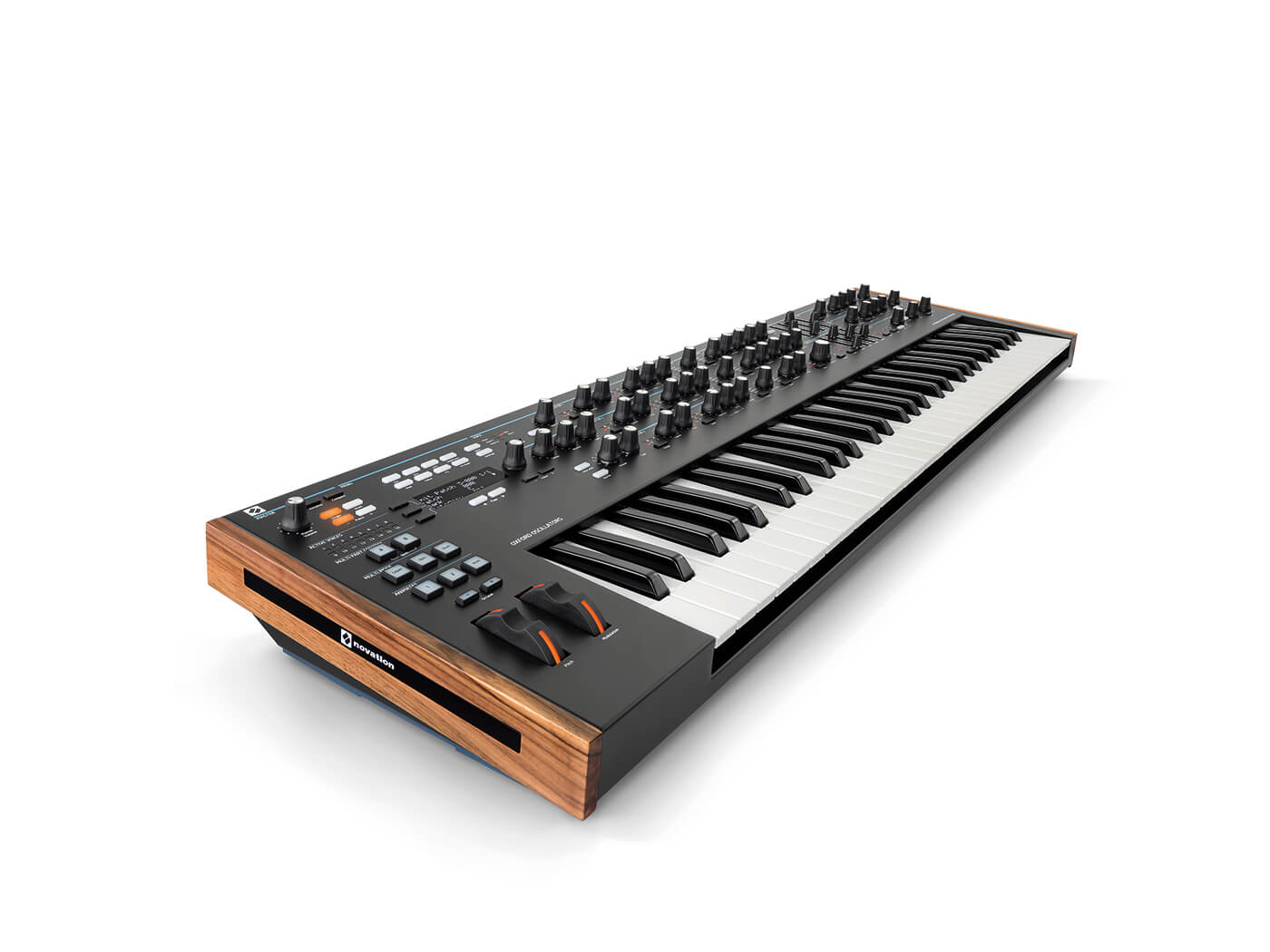
Each of the three oscillators dominate much of the panel, one on top of the other, with options to change course and fine-tune, plus the range of each oscillator on the left of each section. The pitch of individual oscillators can be modulated by both Mod Env 2 and/or LFO 2 with two dials controlling the intensity or depth. As with Peak, all three oscillators on Summit can be modulated simultaneously with LFO 1 with one of the many available modulation options.
The Shape dial lets you adjust the shape of the waveform to introduce more or less harmonic character, either manually or modulated by Envelope 1 or LFO 1. As with Peak, it’s the combination of ’1’ (LFO1 or Envelope 1) modulating shape and ’2’ (LFO2 or Env 2) modulating pitch.
The LFO and Envelope sections are now to the right of Summit. LFO controls include Type (choose from four), Range (three) and dials for Fade Time (which fades the effect in for more drama) and Rate. Both of the Modulation Envelopes are switchable in that section, and above that section is the Amplitude ADSR Envelope for level changes per note. Here, I should also mention the new Global controls for LFO 3 and 4 which are dedicated to global modulation with Peak and Summits, but have now been made ‘real’ on the latter. With no instruction manual in the box, I just experimented with these a little and, yes, the effect is dramatic, so be careful here!
A significant addition to Summit’s Oscillator section is the new FM section, where functionality that did exist with Peak has now been made more hands-on. Here, you get controls to, for example, modulate the frequency of Oscillator 1 with Oscillator 3. Each of the three controls here allows a different combination of which oscillator is modulating which. As with the Shape dial, you can choose to do this manually or by modulation, although this time it is with Envelope 2 or with LFO2. This is a definite highlight – I was quickly getting some eerie electronics going, although perhaps a little too like Radiohead on occasion…
Twice the filtering?
Next to the three oscillators, we enter the filter domain by way of the mixer (with its three Oscillator, Noise and Ring Mod level dials) and Envelope sections (as described above). At first glance, this is identical to that on Peak’s, but look closely and there is a new Dual Filter mode. The filter design might be the same as that used in Peak, but with Dual Filter, Summit introduces some different ways of using it. You still choose between LP, BP and HP types, but beneath these, the new Dual option effectively allows you to ‘split’ the 24dB filter option into two 12dBs and route them differently together.
You choose from one of six paired combinations of the low-pass, high-pass and band-pass modes and the results can be staggeringly different from normal filter fumblings. You might, for example, have a series set up when a low-pass flows into a band-pass, or parallel settings where the signal goes into your filters simultaneously.
However, all of this is accentuated using the Filter Frequency Separation option – a feature I last used under a different name on a Dreadbox – where you then move each of the two filter-cutoff frequencies which splits the effect, giving you (almost) two sounds for the price of one. Like the FM section, this is another Summit hands-on highlight – so do experiment with both sections.
I found it easy to get some very different and out-there filter swellings going, although don’t expect the knobs to do what you necessarily think they will – my brain was hurting a little by this point. It’s all very swirly and dynamic – especially when you start bringing more polyphony in – and tied in with the FM section, this is a must-try sound-design Summit highlight.
Not as hard as it sounds
If all of the talk of modulation, filtration, and oscillation is giving you constipation and sounds quite long-winded, don’t worry, because in practice, Summit is an absolute joy to use, thanks in major part to the screen. You can easily ‘tab’ around it thanks to buttons on its left and it switches over to and shows whatever parameter you are dialling for the duration of your edit and then reverts back to the logical higher level once you’re done. The colour coding and illumination of the various buttons helps here, too and you might even start only using the screen just for fine tuning after a surprisingly short amount of time. Which is just as well, as I did find the screen’s left position a tad too left on occasion and could possibly make a case for it being more central. No biggie, though.
Also in the ‘not as hard as it sounds’ category is the Modulation Matrix. You get 16 combinations of sources, first and second destinations to set up (I counted 22, 22 and 38 respectively) and you set them up within each slot with a Depth range. It’s all done on the screen, but very easy to do.
Other highlights of Summit include Overdrive and Distortion in the analogue domain. These add lovely oomph when needed, but you can also add global digital effects in the form of chorus, delay and reverb; the latter is particularly stunning. All of these effects can now have a signal routed through them via the all new and very welcome audio inputs, too.
I should quickly round up some other new features. Some, like the new Arpeggiator controls, are similar to other additions where the physical controls have been added to do things that Peak may have done in more limited ways, or with features hidden in menus. Here, you get arpeggiator Types, Rhythms, Gate and more proper controls. Another newbie is a dedicated high-pass filter, accessible from a sub menu, just for the noise source.
Outputs have also been bolstered, as you may expect given there’s double the sonic potential, so you get four outs rather than two. There are lots of routing additions, too, both with these outputs and the effects routing for sounds A and B. That’s lots of extras.
To the summit
So finally, how does Summit sound? Well, if you think I’m sounding a little too excited about the intricacies of hands-on FM and Filter Frequency Separation – I’m a joy at parties – then really that’s just some fun to be had on the route to the summit, because it all leads up to the sound… and this mountain is big.
From your first chord, your speakers will be blown away by powerful, very atmospheric and huge pads. There are plenty of dance leads and basses, more than enough eerie alien-type atmospheres – the synth does lend itself so well to ambient and electronica. The Single sounds obviously have it, in terms of weight as they are often the bi-timbral sounds layered, but this latter section is well worth exploring too for its split ideas. Overall, the presets are exceptional, but like no other synth, it’s the places you can take them so easily that counts for so much more. Once you’re at this synth’s summit, the list of routes that you will be able to see from it is almost endless.
Conclusion
I think I’ve made it clear enough not to think of Summit as ‘just’ a pair of Peaks, if for nothing else to stop me getting those bloody Twin Peaks puns going again. Summit does much more than that, or at the very least some of the same stuff, but better. Very often, the Peak stuff that was hidden away in sub menus has now been unleashed by Summit – like the FM stuff, the LFO 3&4 section and more – with controls of its own. And of course, simply having this as such a hands-on option means that you will try it and use it much more.
Which is just as well, as using Summit – and Peak for that matter, because that is still a great synth, too – is where your effort will be paid off with rewards aplenty. Simply experimenting with the new tweakable sections is guaranteed to have you treading new ground sonically.
The fact is that this is one hell of a synth. It faces competition, don’t get me wrong – just look how much the eight- and 16-voice polysynth market has exploded in recent years. I could also quibble about the screen position and the visibility of certain panel writing in low light. But I’m not going to, because I’m not sure that there is any synth out there that presents as many options or implements them in such a digestible way, as Summit does. Between the screen and the buttons, you’ll be climbing the learning curve to the summit of Summit in less time than you might think – especially, perhaps, after getting bogged down in my mid-review mumbo jumbo.
Sorry, got a bit carried away there… But Summit (and Peak) are easy to get carried away with, because there’s that sound – the sound! – which is bigger, fatter and more hair-raisable than ever before on Summit. I’ve been following the Novation story for many years – too many to admit – and every few releases they come up with an absolute belter. This is quite simply the company’s best-ever synth release and a landmark in Novation product releases.
Around the back of Summit
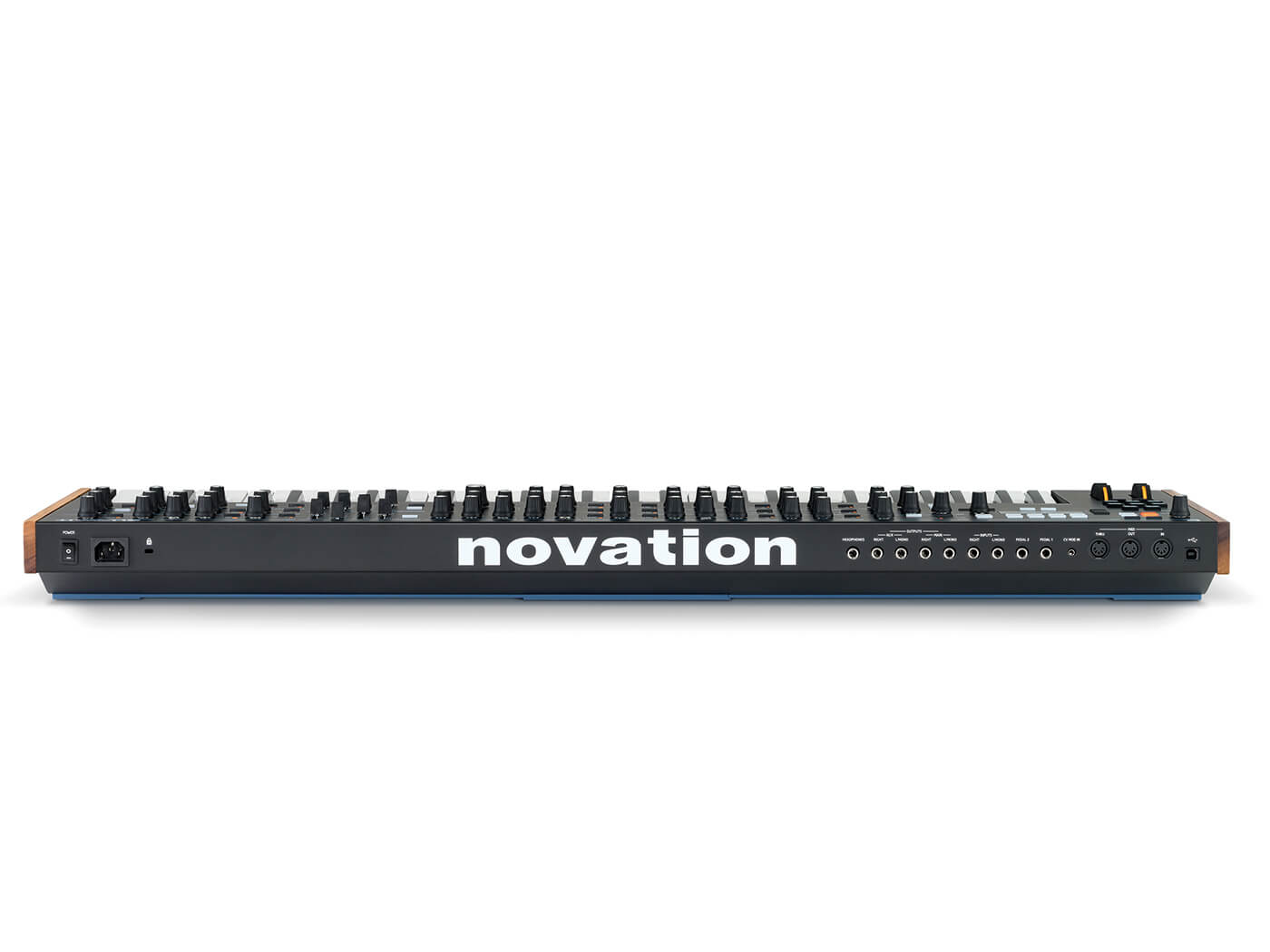 1.Outputs
1.Outputs
On top of the headphone-out jack, both sounds in a bi-timbral setup get their own sets of audio outputs for extra mixing flexibility.
2.Inputs
New audio inputs allow any audio to be routed through Summit’s effects and there’s a CV in for external signal modulation; ie, from a modular setup.
3. Standard
You also get standard MIDI connections, jack sockets for continuous or switched pedals plus USB (MIDI only, not audio; Summit is not buss powered).
Do I really need this?
As a synth fan, I know I always ‘need’ the next big thing. The reality, of course,is that I don’t, and I can probably make do with one or two plug-ins from my DAW. Trouble is, so is everyone else. A product like Summit is a luxury – it’s nearly two grand, after all – but it will take your sound into completely new and better-quality areas than your software (and most hardware, come to that).
Novation Summit – Overview
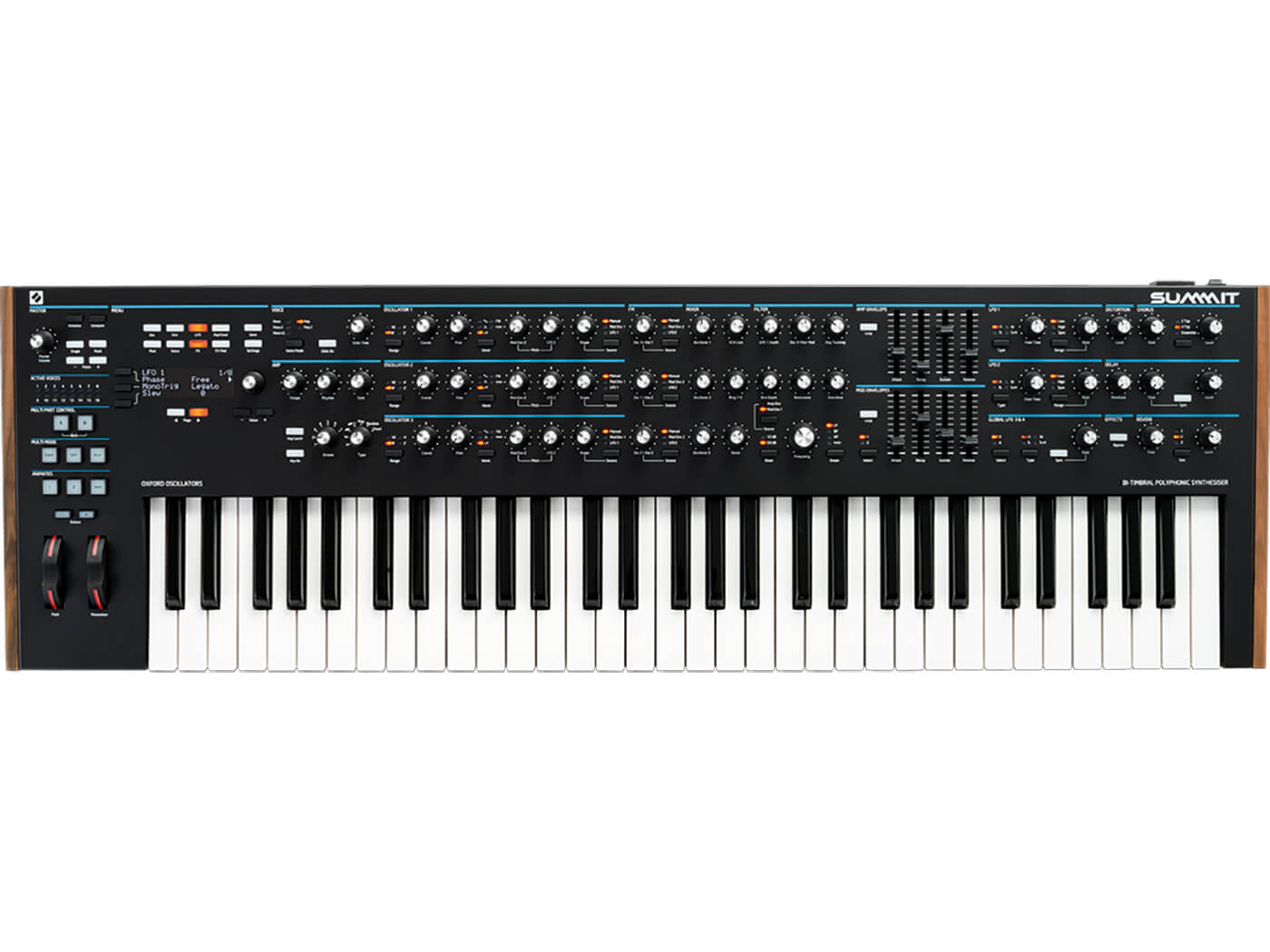
1. Bi-timbrality!
This is the all-new part of Summit that lets you switch between two different sounds from two Peak engines, layer them or trigger them via a sequencer.
2. Three oscillators and FM
Central to Summit in more ways than one, the oscillators kick things off in style from waveforms to 60 waveshapes. There’s a new set of FM knobs, too.
3. Is it a new filter?
A Dual Filter, actually. It looks like the old Peak Filter section, has the old Peak filter but a new Dual Filter mode lets you use it in wonderful new ways.
4. Keyboard
Peak was a synth module, so obviously, this is all-new and the same keyboard as used
on Novation’s fantastic SL MkIII controller.
5. LFOs and envelopes
It’s LFO 1 and Mod Envelope 1 to modulate shape; number 2 of each to modulate pitch. There’s also a new LFO 3 and 4 section to modulate effects.
6. Effects (lots)
Summit has an analogue signal path that takes it through crunchy distortion and overdrive and lovely global digital effects. Check the reverb out!
Key features
● Bitimbral hybrid polysynth
● 2 (big) sounds at once
● Layered, Split and Bi-timbral
● 16-voice polyphony (depending on sound used)
● 5 Voice Modes: Mono, MonoLG, Mono2, Poly, Poly2
● 3 osc, ring mod, 2 LFOs, amp/2 mod envs, filter/voice
● Waveforms: sine, tri, square plus 43 wavetables
● Filter: 12/24dB slopes; low/band/hi-pass and dual filter
● Connections: audio I/O (3.5mm), MIDI I/O, USB
● Hue mod and FX options
● Connections: 2x pedal, 4 out, 2 in (+cv), headphone
Alternatives

Korg
Prologue 16 £1,320
I haven’t reviewed the 16-voice Prologue but reviewed (and own) the Minilogue XD, so can vouch for this more powerful hybrid. More ’analogue’ than Summit, it still boasts lots of flexibility (thanks to its Multi Engine) effects and more, for less cash.
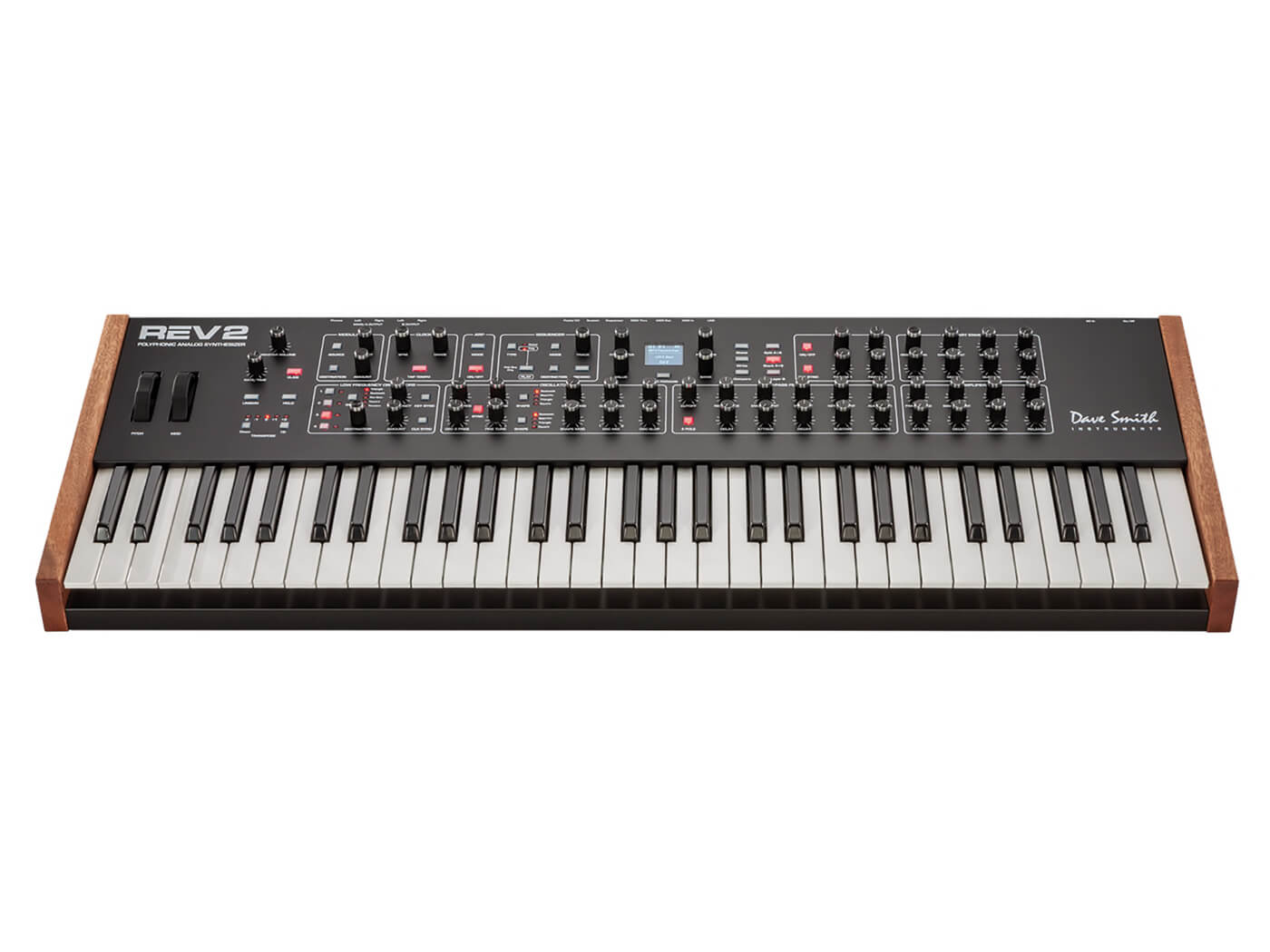
Dave Smith Instruments
Prophet REV2 £1,699
I like to add alternatives I’ve reviewed, which this is not, but I did fall in love with both the DSI Ob-6 and Prophet 06. This is the ’reimagining’ of the 08 with similar specs to Summit and even a bit of bi-timbral.
